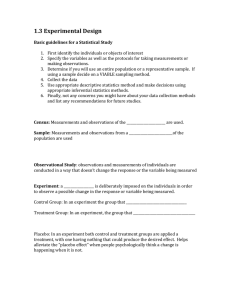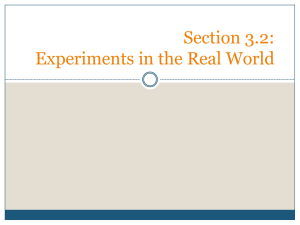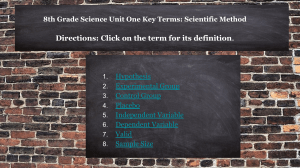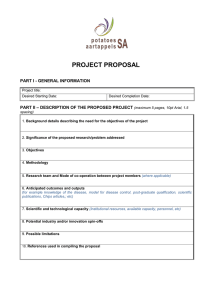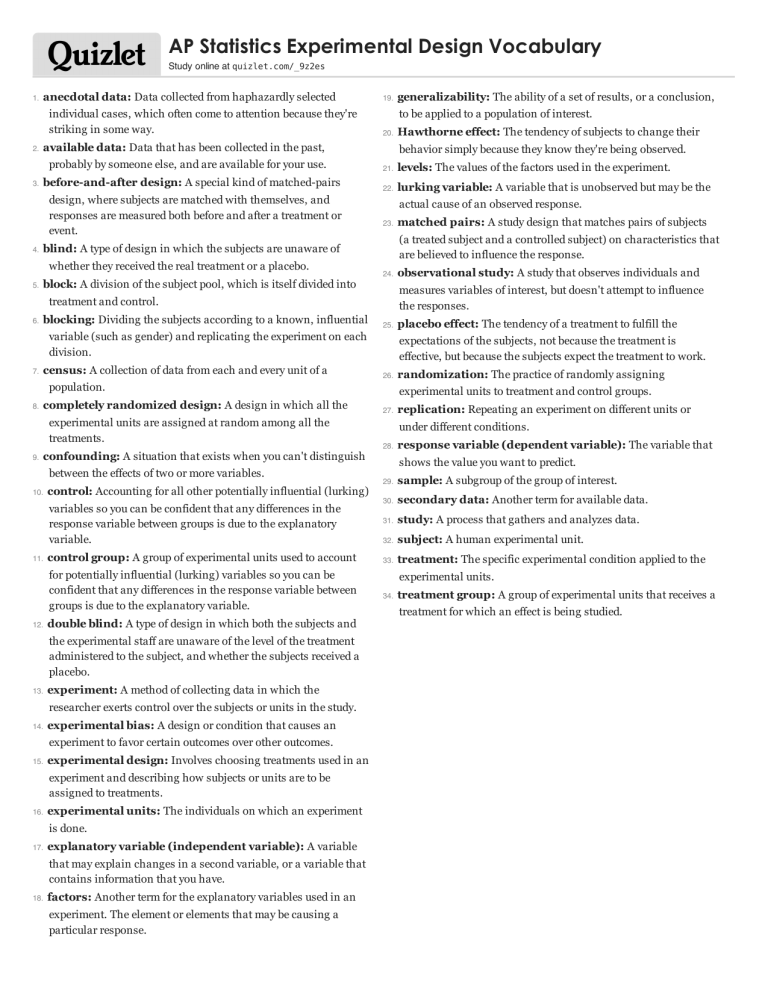
AP Statistics Experimental Design Vocabulary Study online at quizlet.com/_9z2es 1. anecdotal data: Data collected from haphazardly selected individual cases, which often come to attention because they're striking in some way. 2. before-and-after design: A special kind of matched-pairs design, where subjects are matched with themselves, and responses are measured both before and after a treatment or event. 4. 5. 20. block: A division of the subject pool, which is itself divided into 21. levels: The values of the factors used in the experiment. 22. lurking variable: A variable that is unobserved but may be the actual cause of an observed response. 23. blocking: Dividing the subjects according to a known, influential 24. census: A collection of data from each and every unit of a 25. completely randomized design: A design in which all the experimental units are assigned at random among all the treatments. 9. confounding: A situation that exists when you can't distinguish between the effects of two or more variables. 10. control: Accounting for all other potentially influential (lurking) variables so you can be confident that any differences in the response variable between groups is due to the explanatory variable. 11. control group: A group of experimental units used to account for potentially influential (lurking) variables so you can be confident that any differences in the response variable between groups is due to the explanatory variable. 12. double blind: A type of design in which both the subjects and the experimental staff are unaware of the level of the treatment administered to the subject, and whether the subjects received a placebo. 13. experiment: A method of collecting data in which the researcher exerts control over the subjects or units in the study. 14. experimental bias: A design or condition that causes an experiment to favor certain outcomes over other outcomes. 15. experimental design: Involves choosing treatments used in an experiment and describing how subjects or units are to be assigned to treatments. 16. experimental units: The individuals on which an experiment is done. 17. explanatory variable (independent variable): A variable that may explain changes in a second variable, or a variable that contains information that you have. 18. factors: Another term for the explanatory variables used in an experiment. The element or elements that may be causing a particular response. placebo effect: The tendency of a treatment to fulfill the expectations of the subjects, not because the treatment is effective, but because the subjects expect the treatment to work. 26. population. 8. observational study: A study that observes individuals and measures variables of interest, but doesn't attempt to influence the responses. variable (such as gender) and replicating the experiment on each division. 7. matched pairs: A study design that matches pairs of subjects (a treated subject and a controlled subject) on characteristics that are believed to influence the response. treatment and control. 6. Hawthorne effect: The tendency of subjects to change their behavior simply because they know they're being observed. blind: A type of design in which the subjects are unaware of whether they received the real treatment or a placebo. generalizability: The ability of a set of results, or a conclusion, to be applied to a population of interest. available data: Data that has been collected in the past, probably by someone else, and are available for your use. 3. 19. randomization: The practice of randomly assigning experimental units to treatment and control groups. 27. replication: Repeating an experiment on different units or under different conditions. 28. response variable (dependent variable): The variable that shows the value you want to predict. 29. sample: A subgroup of the group of interest. 30. secondary data: Another term for available data. 31. study: A process that gathers and analyzes data. 32. subject: A human experimental unit. 33. treatment: The specific experimental condition applied to the experimental units. 34. treatment group: A group of experimental units that receives a treatment for which an effect is being studied.
